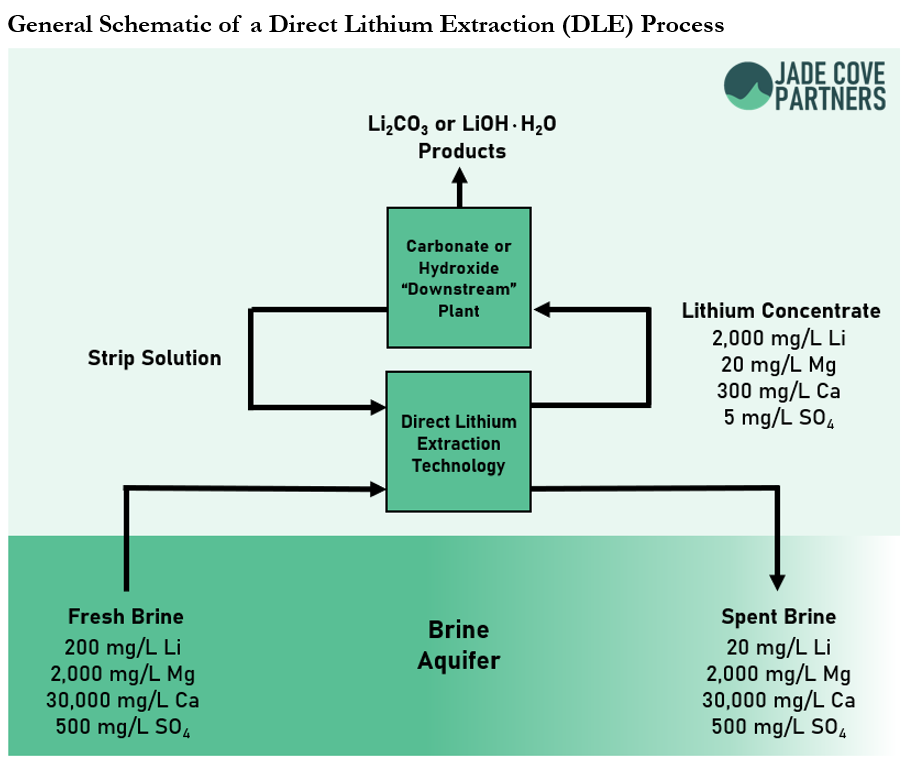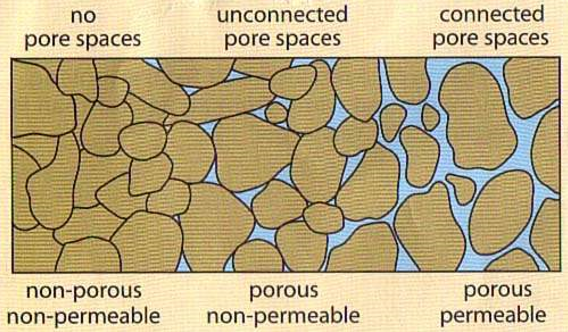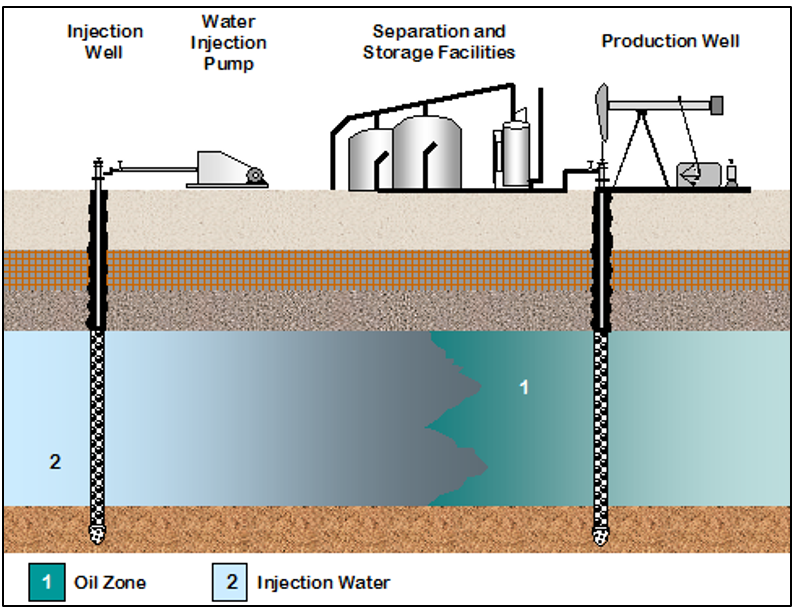Re-Injection Enhanced Production for Direct Lithium Extraction (DLE) Projects
Alex Grant, Principal, Jade Cove Partners, San Francisco, USA
Gene Morgan, CEO, Zelandez, Santa Cruz, Bolivia
December 2019
The PDF of this article is available here and its associated LinkedIn post is available here.
Lithium is conventionally extracted from salar brines in South America using evaporation pond systems. In this process, almost all of the water in the brine is evaporated into the air and impurity salts like NaCl and KCl are crystallized sequentially as the concentration of LiCl increases to a target concentration for processing. This process works well for very high-grade brines in very dry places like the Atacama Desert in Chile, but few other brine resources like that exist in the world. To sate the world’s lithium appetite for electric vehicle batteries, other lower grade, higher impurity brines are being developed using more sophisticated processing routes.
Direct lithium extraction (DLE) is an alternative class of extraction technology in which lithium is removed from raw brine without the need for evaporation ponds and without the need to crystallize/precipitate impurity salts. It has many benefits including lack of dependency on climate/low precipitation, much higher overall recoveries (80-90% vs. 30-50% for typical evaporation pond systems), the ability to quickly create a high purity concentrate which can be easily processed into battery quality materials, and the ability to process brines with lower grades and higher impurities (like magnesium and calcium) that is uneconomic using conventional evaporation. Most participants in the lithium industry are hopeful for this class of technology to be adopted widely because of its many benefits, but some unanswered questions remain.
One of them is the 500L/s elephant in the room: what do you do with the brine after you’ve extracted the lithium from it using a DLE process on a salar? Re-injection is not a common feature of evaporative lithium projects and new, innovative hydrogeological strategies are needed to handle it at DLE projects to avoid mixing fresh brine feeds with brine that has had the lithium removed. These strategies are multidisciplinary; requiring inputs from chemical engineers, hydrogeologists, geochemists, and others to de-risk the project. They are also hyper-specific to the DLE process, the resource and its hydrogeology. Just as some DLE processes work for some projects and not all, some spent brine strategies will only work for some DLE projects. In this article, we will discuss the key hydrogeological concepts used to manage salar brine aquifers, and identify promising techniques from other industries which may not only help manage the risk of spent brine re-injection, but potentially improve both the environmental impact and economic return of DLE projects.
Hydrogeology of Salar Brine Aquifers
All salar brine aquifers consist of pores in sediments or salt formations and the rate of brine production from those aquifers depends on the ratio of pore space to total volume, and how fast the brine can travel through the connections between the pores. These are geological concepts called porosity and permeability, respectively.
In general, fluids flow when a pressure differential exists in the direction from high pressure to low pressure. Brine is removed from a salar when a pump, installed in a production well, is used to create a region of low pressure in the brine aquifer, which draws fluid towards the intake of the pump. The rate at which the fluid flows towards the low-pressure point in the salar is determined by the porosity and permeability of the aquifer under the salar. The pressure differential in the salar and the flow rate are linked, so a higher-pressure differential will result in a higher flow. For a given pressure differential, a high permeability aquifer will show higher flow compared to a low permeability aquifer. An example of when pressure/permeability are not “matched” is the observation of a “coning out” event. This is when the pump in a production well is pumping excessively and sucks all of the brine out of a region in the aquifer faster than brine is able to flow into that region, causing a cone void space in three dimensions. It is less common in aquifers like the Salar de Atacama’s halite-dominated aquifers, which have high permeabilities. However, now that new resources with more sand/clay/silt sedimentary geology are developed, especially in Argentina, there is greater chance of encountering lower permeability brine aquifers, which also may be lower grade and less pure, requiring DLE processing.
Something important to consider is that if brine is pumped from the aquifer too aggressively (even despite avoiding local “coning out” events), then the level of brine in the aquifer will drop with time. The level of brine in the aquifer will only be constant if the rate of fluid flow into the aquifer is balanced with the rate of brine produced from production wells. The fluid flow “recharge” into the aquifer can originate from any of the following sources:
Rain events either on salar or from mountain run-offs,
Aquifers deeper than the target aquifer feeding from below,
Aquifers adjacent to the salar of either lower grade brine or freshwater,
Geothermal sources.
In all of these cases, fluid flows in to recharge the producing aquifer to maintain its natural equilibrium. In many cases, a fluid flows into the salar which contains less lithium than the target aquifer. This means that infiltration of lower lithium grade fluids into the salar aquifer is a likely consequence of brine production. This has not been studied in detail because most data from monitoring wells is confidential, but a 2016 article published in Geophysical Research Letters estimated that the Salar de Atacama’s recharge is about 4 times its topographic watershed. (1)
If brine is pumped out too quickly, it is possible to drop the level of brine so much that a voidage replacement problem can occur, where the recharge of brine to the aquifer is not happening fast enough and the sediment pores are left dry. This can cause a pressure decline in the aquifer and can lead to a permanent reduction of porosity and permeability of the aquifer, due to compacting of the sediments and subsequently lower brine production performance. On the surface, a “sinking salar syndrome” can be observed (surface subsidence) significant enough to cause damage to wellfield completions and surface infrastructure.
To understand the hydrogeological behavior of salar aquifers over the life of lithium projects, either DLE or evaporative, it is critical to understand how pressure affects flows in the aquifer. We think that an interesting opportunity to explore in lithium brine extraction for salar projects is “active management” of pressure, which may not have been critical in the past for evaporation pond projects, but is common in other industries, and may become more important in the future for salar brine projects of varying hydrogeologies, especially those which use DLE processes.
In O&G (where Gene spent much of his career), injection has been used widely for many decades and pressure management of aquifers is a key technique for maximizing oil recovery in mature oilfields. Most commonly this is done with the injection of water or brine, known as waterflooding, with the aim of compensating for the natural decline of an oil field's production by increasing the pressure in the reservoir. We believe that the spent brine from DLE processes could be considered an opportunity to drive brine production from salar aquifers. The O&G industry is familiar with using active management tools and techniques to optimize these operations. How could these tools and techniques be adapted to salar brine aquifers?
Spent Brine in Salar DLE Projects as an Opportunity
Re-injection of spent brine at DLE projects may give hydrogeologists a tool for managing the salar aquifer in a more sophisticated way than relying on natural recharge. Below are some ideas for how spent brine could be considered an opportunity for salar DLE projects:
Spent brine can be re-injected at the periphery of salars, substituting the natural infiltration of lower grade brines or freshwater into the salar aquifer as lithium brine is removed. This could act like a “brine barrier”, where the spent brine acts as a wedge between the fresh brine of the producing aquifers and fluid from undesirable off-salar aquifers with different density and geochemistry.
By re-injecting spent brine, aquifer pressure could be maintained, preventing the voidage replacement problem, maintaining high aquifer performance, and preventing the “salar sinking syndrome”.
The higher pressure at the periphery of the salar could enhance brine production by driving fresh brine towards the production wells. Since water is incompressible, it may be possible to apply this pressure far away from production wells where dilution of the fresh brine is minimized. On top of the process benefits of DLE including higher lithium recovery, no weather dependence, and faster commissioning, this can improve project economics by achieving positive and larger cash flow from lithium product sales sooner.
Resource-specific hydrogeological modeling is one requirement in the design of a spent brine re-injection strategy, and we believe that borrowed techniques from O&G could be used in that modeling. We call the management of spent brine from a DLE process to control pressure of a salar aquifer and enhance brine production “Re-injection Enhanced Production”, or “REP”. A schematic of REP is shown below.
How Re-Injection Enhanced Production Could Improve Project Economics
Making some simple assumptions for development of a theoretical lithium brine salar resource, we modeled the NPV of developing the project using either evaporation ponds relying on natural recharge, DLE relying on natural recharge, and DLE using REP. If REP could boost brine production rates by 20% compared to relying on natural aquifer recharge & pressure decline, and recoveries are around double for DLE compared to evaporation ponds, then the following results could be achieved.
The potential “above ground” benefits of DLE are widely acknowledged throughout the lithium industry, and we believe the potential “below ground” benefits of REP should also be considered in project economic modeling since it could allow for lithium to be extracted on a shorter timeline, returning value to investors sooner, increasing NPV. Spent brine re-injection is very project specific, and REP may not work for all salar aquifers for hydrogeological reasons.
Early Days for Spent Brine Re-Injection at Salar DLE Projects
So far, the experience of spent brine management in South America has been limited. At least one developer has asked the provincial government of Salta in Argentina for a permit to dispose of spent brine at their salar. Unfortunately, that developer was proposing to use a DLE process which leaves residual contaminants in the spent brine. The press learned about this, and the scrutiny of the provincial government was intense to cross every “t” and dot every “i”. The result was that the permitting process for spent brine disposal took 3 years. In the end, a permit was granted, but we believe that this developer made a poor technology selection that unnecessarily hindered their progress. The golden rule of DLE processes and any spent brine re-injection is to not introduce foreign materials to the salar aquifer, and there is significant above ground work to be done for each project to ensure that this is not the case, depending on the type of DLE process being implemented.
The Argentine arm of the geological consulting company SRK has previously studied spent brine disposal for salar DLE projects. Their recommendations in a 2018 report were to use a hybrid approach for spent brine disposal, notably to use un-lined (simpler, cheaper) evaporation ponds to evaporate some of the spent brine and to allow the rest of it to infiltrate slowly in the aquifer at a location on the salar that minimizes spent brine and fresh brine mixing. (2) They noted that if a DLE process were to recover 50% of the lithium from brine and the spent brine could be concentrated by a factor of 2 before being re-injected or infiltration into the salar aquifer, then the re-injected brine would have the same grade as the fresh brine.
We believe this approach could be valuable for some resources and the CAPEX savings for liner-less ponds could be significant versus the alternative. However, this may be less desirable for lower grade South American brines because it means some of DLE’s “step change” improvements over evaporation ponds cannot be realized for those resources, including minimal footprint on the salar. This could mean only a few of the highest grade salars in South America would be amenable to development, which could limit the economic potential of the region. For these reasons, we believe the use of evaporation ponds to dispose of spent brine from a DLE process may not be an optimal solution. This applies for all DLE processes but does not apply to all resources, emphasizing the importance of technology-resource fit.
Aquifer pressure management could help drive brine production for evaporation pond projects too, but large quantities of geochemically compatible fluid may not be available for those projects since the brine is lost to evaporation during pond processing. What a missed opportunity!
Future Work
Zelandez has begun a research collaboration where we will continue working on solving the technological & hydrogeological challenges of developing new kinds of brine resources using DLE processes in South America and beyond. This is a preliminary exploration of the opportunities of spent brine re-injection, and we look forward to proving out some of these concepts for real projects. Below is a selection of some of the questions we will be working on in 2020 and beyond:
What are the thermodynamic, hydrogeological, and mechanical drivers of spent and fresh brine mixing and how can it be managed?
How does the geology of the aquifer affect this mixing?
How can geological structures in salars like impermeable layers be used to maximize pressure enhancement?
What needs to be done above ground to ensure the DLE processing of the brine is compatible with the geochemistry of the salar aquifer?
Conclusions
Spent brine re-injection at salar DLE projects in South America has historically been under-investigated thus considered a risk. After detailed discussions with some of the most experienced salar hydrogeologists, we believe spent brine re-injection represents a major opportunity to optimize brinefield management and improve project economics.
We believe it is important to focus on eliminating hurdles to adoption of DLE processes. By combining advanced technologies with industry know-how, we believe the step-change benefits of DLE can be realized in the next decade. The world needs much more battery-quality lithium chemicals if lithium demand projections for electric vehicles in the 2020s are realized.
Acknowledgements
Thank you to Murray Brooker (Zelandez Geoscience - Hydrogeologist Qualified Person, Australian Institute of Geoscientists), Ignacio Ezama (SRK - Professional Engineer, COPAIPA, Salta, Argentina), Steve Shikaze (Matrix Solutions - Professional Engineer, PEO, APEGA, APEGS), Gordon MacMillan (Fluid Domains, Professional Geologist, APEGA), Matt Uddenberg (Stravan Consulting - Licensed Geologist, Washington State, ASBOG), and others for their input and expert opinions which helped shape this research article.
References
(1) Corenthal, 2016. Regional groundwater flow and accumulation of a massive evaporite deposit at the margin of the Chilean Altiplano. URL.
(2) Ezema, 2018. Direct Extraction Lithium Processes: The Challenges Of Spent Brine Disposal. URL.





